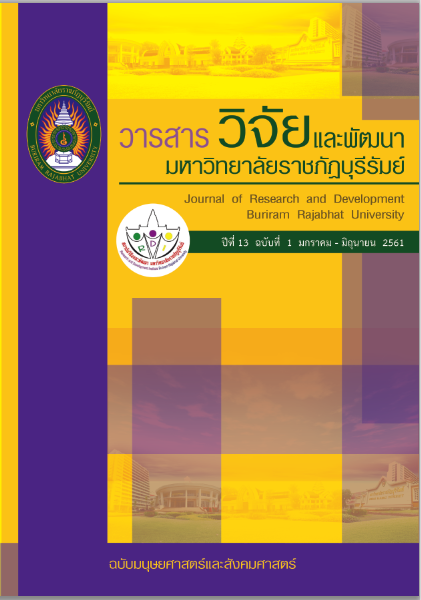การสร้างความจงรักภักดีต่อแบรนด์สินค้า HI-END ในเขตกรุงเทพมหานคร
Main Article Content
บทคัดย่อ
ปัจจุบันตลาดธุรกิจที่เกี่ยวข้องกับสินค้า Hi-END มีการแข่งขันกันสูงขึ้นอย่างต่อเนื่องในหลายประเทศทั่วโลก อันเนื่องจากความภักดีต่อตราสินค้า Hi-END ซึ่งถือเป็นเป้าหมายสำคัญทางการตลาดจึงนำไปสู่พฤติกรรมการซื้อซ้ำและจงรักภักดีแบบยั่งยืน การวิจัยนี้จึงมีวัตถุประสงค์เพื่อ 1) ศึกษาระดับของภาพลักษณ์ การบูรณาการเครื่องมือการสื่อสาร ปัจจัยเชิงจิตวิทยา ความพึงพอใจ และความจงรักภักดีของลูกค้าที่มีต่อแบรนด์สินค้า Hi-END ในเขตกรุงเทพมหานคร 2) ศึกษาอิทธิพลเชิงสาเหตุของภาพลักษณ์ การบูรณาการเครื่องมือการสื่อสาร ปัจจัยเชิงจิตวิทยา และความพึงพอใจที่มีต่อความจงรักภักดีของลูกค้าในแบรนด์สินค้า Hi-END ในเขตกรุงเทพมหานคร การวิจัยนี้ใช้วิธีผสมผสาน (Mixed Methods) เป็นการวิจัยเชิงปริมาณและเชิงคุณภาพ กลุ่มตัวอย่างที่ใช้ในการวิจัยคือผู้บริโภคที่ใช้บริการสินค้าแบรนด์สินค้า Hi-END จำนวน 294 คน ใช้วิธีการสุ่มตัวอย่างแบบหลายขั้นตอน ใช้แบบสอบถามเป็นเครื่องมือในการเก็บรวบรวมข้อมูล วิเคราะห์ข้อมูลด้วยสมการโครงสร้าง การวิจัยเชิงคุณภาพ ใช้วิธีการสัมภาษณ์แบบเจาะลึกกับผู้เชี่ยวชาญนักการตลาด จำนวน 17 คน ผลการวิจัยพบว่า 1) การบูรณาการเครื่องมือสื่อสาร และปัจจัยเชิงจิตวิทยา อยู่ในระดับที่มาก ส่วนภาพลักษณ์ของแบรนด์สินค้า ความพึงพอใจของลูกค้า และความจงรักภักดีของลูกค้าที่มีต่อแบรนด์สินค้า อยู่ในระดับปานกลาง 2) ภาพลักษณ์ของแบรนด์สินค้า การบูรณาการเครื่องมือสื่อสาร ปัจจัยเชิงจิตวิทยา และความพึงพอใจของลูกค้า มีอิทธิพลต่อความจงรักภักดีของลูกค้าที่มีต่อแบรนด์สินค้า นอกจากนี้งานวิจัยเชิงคุณภาพ พบว่า ความเป็นตัวตน ความเป็นเอกลักษณ์ของตัวผลิตภัณฑ์ของสินค้าเอง มีส่วนสำคัญในการดึงดูดให้ลูกค้าเกิดความภักดี การวิจัยครั้งนี้สามารถนำไปใช้ในการวางแผนกลยุทธ์ทางการตลาดเพื่อให้เกิดความได้เปรียบทางการแข่งขัน
Article Details
เนื่อหาและข้อมูลในบทความ เป็นความรับผิดชอบของผุ้แต่ง
บทความในวารสารเป็นลิขสิทธิ์ของวารสารวิจัยและนวัตกรรมท้องถิ่น
เอกสารอ้างอิง
2. Adjei, M. T., Noble, S. M., & Noble C. H. (2010). The influence of C2C communications in online brand communities on customer purchase behavior. Journal of the Academy Marketing, 38 (5), 634-653.
3. Aggarwal, Pankaj and Ann L. McGill. (2012). When Brands Seem Human, Do Humans Act Like Brands? Automatic Behavioral Priming Effects of Brand Anthropomorphism. Journal of Consumer Research, 39 (August), 307–23.
4. Akar, E. & Mardikyan, S., (2014). ‘Analyzing factors affecting users’ behavior intention to use social media: Twitter. International Journal of Business and Social Science, 5(11), 85–95.
5. Alan, B. & Robert, B, G. (1995). Analyzing qualitative data. London; New York:
Routledge.
6. Al-Borie, H.M,. Damanhouri, A.M.S. (2013), Patients’ satisfaction of service quality in Saudi hospitas: A Servqual analysis. International Journal of Health Care Quality Assurance, 26(1), 20-30.
7. Amatulli, C. & Guido, G. (2011). Determinants of purchasing intention for fashion luxury goods in the Italian market. Journal of fashion marketing and management. 15(1), 123-136.
8. Asad-ur Rehman (2014). IMPACT OF CUSTOMER SATISFACTION ON BRAND LOYALTY- AN EMPIRICAL ANALYSIS OF HOME APPLIANCES IN PAKISTAN Published by European Centrefor Research Training and Development UK (www.eajournals.org) .British Journal of Marketing Studies, 2(8), 18-32.
9. Azize, S., Cemal, Z. and Hakan, K., (2011). The Effects of Brand Experiences, Trust and Satisfaction on Building Brand Loyalty; an Empirical Research on Global Brands. Precede Social and Behavioral Sciences, 24, 1288–1301.
10. Bang, N., Melewar, T. C., & Chen, J. (2013). The brand likeability effect: Can firms make themselves more likeable. Journal of General Management, 38(3), 25-50.
11. Barnier, Falcy, & Valette-Florence. (2012). Do consumers perceive three levels of luxury. The Journal of Brand Management, 19 (5), 1-14.
12. Bayus, B. L. (2010). Crowdsourcing and individual creativity over time: The detrimental effects of past success. Working Paper Series.
13. Bryson, D., Atwal, G., & Dreissig, M. (2010). Brand hate is more than just a feeling. Admap, 32–33.
14. Campbell, M. C., & Mohr, G. S. (2011). Seeing is eating: How and when activation of a negative stereotype increases stereotype-conducive behavior. Journal of Consumer Research, 38(3), 431–444.
15. Cemal, Z, Azize S, Hakan K., Mehtap Ö. (2011) "The Effects of Brand Communication and Service Quality in Building Brand Loyalty Through Brand Trust; The Empirical Research On Global Brands ", Procedia Social and Behavioral Sciences, 24, 1218–1231.
16. C.-F. Chen and O. Myagmarsuren (2011). Brand equity, relationship quality, relationship value, and customer loyalty: Evidence from the telecommunications services. Total Quality Management, 22(9), 957–974.
17. Chebat, J., Davidow, M., & Borges, A. (2011). More on the role of switching costs in service markets: A research note. Journal of Business Research, 64(8), 823–829.
18. Davies, G., & Chun, R. (2012). Employee as symbol: Stereotypical age effects on corporate brand associations. European Journal of Marketing, 46 (5), 663– 683.
19. Dimofte, C. V., & Yalch, R. F. (2011). The mere association effect and brand evaluations. Journal of Consumer Psychology, 21, 24–37.
20. Ding Hooi, T. et al., (2011). Dependency on Smartphone and the impact on purchase behavior, Young consumers, 12(3),193-203.
21. Edelman, D. C. (2010). Branding in the digital age. Harvard Business Review, Dec. 2010, 88(12).
22. Eckert, C., & Hughes, B. (2010). The root of the cause. Industrial Engineer Journal, 42(2), 38-43.
23. Elisa Arrigo (2011). Fashion, Luxury and Design: Store Brand Management and Global Cities Identity.
24. Hair, et al. (2006 ). SEM: confirmatory factor analysis.


